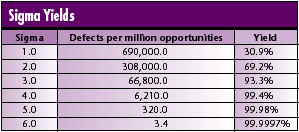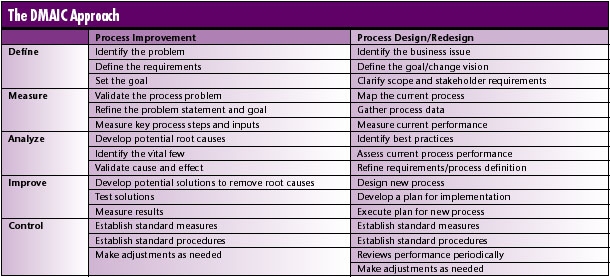| by Andrew Spanyi and Marvin Wurtzel
Within large corporations,
Six Sigma’s popularity as a means of improving quality
and reducing costs continues to increase. However, the same
can’t be said of small and medium-sized organizations,
which, as a rule, have been less enthusiastic about adopting
Six Sigma. Many have scaled back and believe they can neither
afford the luxury of a complicated Six Sigma program nor
justify the outlay required to train a Master Black Belt.
Nevertheless, smaller companies should consider that business
process principles underlying the Six Sigma approach, as
well as some of the program’s specific tools, offer
an effective means for significantly improving their performance
levels. Consider some of the more important principles and
tools that smaller businesses can utilize without launching
a major initiative.
As you likely know, Motorola developed Six Sigma during
the 1980s. It was subsequently adopted by leading corporations
such as GE, Sun Microsystems, AlliedSignal and Bank of America.
Six Sigma offers a structured method to improve performance.
Its methodology is based on established statistical process
control techniques, data analysis methods and systematic
training of all personnel involved in the activity or process
targeted by the program. Six Sigma is a well-structured,
data-driven methodology for eliminating defects, waste or
quality problems in manufacturing, service delivery, management
and other business activities.
The Greek letter s is also a mathematical symbol that
represents a measure of variation, the distribution around
the mean of any process or procedure. The term “six
sigma” defines an optimum measurement of quality:
3.4 defects per million events. If an organization can reduce
its product’s average deviation, then less of it will
be faulty and cost savings result. In other words, do it
right the first time by progressively monitoring and eliminating
mistakes.
Ideally, Six Sigma is based on customer knowledge and
accurate performance measures of the core processes that
fulfill those requirements. Understanding what the customer
considers “critical to quality” is a cornerstone
of any successful Six Sigma initiative. The link between
Six Sigma and business process thinking often determines
the span and depth of performance improvements. Both incremental
business process improvement and Six Sigma are intended
to develop focused solutions to eliminate root causes of
business performance problems without radically changing
existing processes or organizational structure.

The Six Sigma approach incorporates five critical processes:
define, measure, analyze, improve and control. An organization
identifies a problem area, measures it, identifies its root
cause, and then fixes and controls it.
 Define. This step is concerned with defining project
goals and boundaries, and identifying issues that must be
addressed to achieve an improved sigma level (i.e., defect
rate).
Define. This step is concerned with defining project
goals and boundaries, and identifying issues that must be
addressed to achieve an improved sigma level (i.e., defect
rate).
 Measure. During this step, information about the
current situation is gathered in order to obtain baseline
data on current process performance and identify problem
areas.
Measure. During this step, information about the
current situation is gathered in order to obtain baseline
data on current process performance and identify problem
areas.
 Analyze. This step focuses on identifying root
causes of quality problems and confirming those causes with
appropriate data analysis tools.
Analyze. This step focuses on identifying root
causes of quality problems and confirming those causes with
appropriate data analysis tools.
 Improve. During this step, solutions are implemented
to address the root causes of problems identified during
the analysis phase.
Improve. During this step, solutions are implemented
to address the root causes of problems identified during
the analysis phase.
 Control. Here, the previous improvement phase is evaluated
and monitored.
Control. Here, the previous improvement phase is evaluated
and monitored.

Why should small and medium-sized businesses seriously
consider Six Sigma tools as a means to improve quality?
Because the business process model underlying Six Sigma
represents a major opportunity for cost savings. Smaller
enterprises typically have ad hoc business processes. Error
rates often hover in the 20- to 30-percent range, and opportunities
for performance improvement are proportionately high. Moreover,
because of its manageable size and relatively few entrenched
“silos,” a smaller business environment is generally
more conducive to new business process thinking than a large
corporate setting.
Small to medium-sized businesses that have successfully
implemented Six Sigma usually began by identifying core
business processes--those that deliver value to customers.
These tend to be cross-functional in nature. Keep in mind
that there’s a difference between a department and
a process. Crucial to any improvement effort is the understanding
that work must pass through various departments in order
to produce value for the customer. After identifying core
processes, an organization must identify the scope of improvement
needed to ensure the processes consistently deliver strategic
commitments.
Because many small to medium-sized enterprises operate
their business processes at the 2 to 3 sigma level, an improvement
of even 1 sigma represents a huge step in improving customer
satisfaction and reducing costs. Through a better understanding
of their core processes, smaller businesses can make significant
improvements rapidly. For example, if a business with an
order fulfillment process operating at 3 sigma (or 66,000
defects per million opportunities) could improve performance
to the 4 sigma level (or 6,210 defects per million opportunities),
it would realize about a 10X gain in performance. And if
each error cost as little as $10 to fix, the resulting cost
savings would be in the range of $600,000.
In addition, smaller businesses often rely on management
methods that are more spontaneous than controlled. These
companies could benefit from Six Sigma’s structured,
data-driven methodology for eliminating defects, waste or
quality problems of which the cause is unknown.
First, identify your organization’s key business
processes that deliver value directly to the customer. Don’t
confuse them with the support processes (e.g., human resources,
budgeting or facilities that are required to run the operation).
Most companies have between five and eight core customer-
and/or mission-
critical business processes such as order fulfillment new
product development. Map these processes at a midlevel and
measure the current process results. Detailed process flows,
like those you’d find at the work-instruction level,
aren’t necessary here. Instead, outline the major
handoffs between functional organizations of the business.
Next, identify the most important issues or “disconnects”
between the customer and the company perspective, and involve
the leadership team in prioritizing them.
You must next decide on the required scope of improvement
and whether to perform process improvement or process redesign.
A comparison of the two choices is illustrated. Process
improvement usually fixes a segment of a larger process,
whereas process redesign involves building a new process
to replace an old one. Initially, small to medium-sized
businesses should begin by performing process improvement
using basic Six Sigma methodology and then measure the results
and quantify the savings.
Although these steps appear straightforward, they’re
far from effortless. In fact, the following are just some
of the elements needed for success:
 Visible management commitment
Visible management commitment
 Keen sense of urgency
Keen sense of urgency
 Clear definition of customer requirements
Clear definition of customer requirements
 Shared understanding of core processes and key customers
Shared understanding of core processes and key customers
 Honesty in measuring current performance
Honesty in measuring current performance
 Discipline in prioritizing the critical few improvement
projects
Discipline in prioritizing the critical few improvement
projects
 Communicating success stories and proving that the approach
works
Communicating success stories and proving that the approach
works
 Rewarding and recognizing the performers
Rewarding and recognizing the performers
 Institutionalizing the approach
Institutionalizing the approach
These factors can sometimes be challenging for smaller
businesses whose leadership is susceptible to ever-changing
priorities. Yet the potential rewards are significant. As
reengineering expert Michael Hammer has argued, Six Sigma’s
power is optimized when applied to “inside the box”
problems that don’t challenge the existing process’s
structure. Accordingly, it can be argued that, compared
to large corporations, smaller businesses are even more
likely to benefit from applying Six Sigma methods because
many of their problems are execution-oriented and difficult
to find. In contrast, larger companies must often address
fundamental problems in the design of the business process
or organizational structure.
Smaller businesses shouldn’t be deterred by the
some of the myths surrounding Six Sigma.
One of these is the necessity for Black Belts and Green
Belts. Although this is required for large corporations,
it isn’t necessarily for smaller businesses. Six Sigma
tools aren’t altogether new; they build on well-known
total quality management techniques from the 1980s and statistical
process control tools from the 1930s and 1940s.
It’s also not necessarily true that everyone must
have weeks of Six Sigma training before implementation.
If the program is properly structured and delivered, smaller
businesses can take advantage of just-in-time practices
when applying Six Sigma.
Another common misconception is that setting big goals
might prevent the program’s success. Smaller businesses
are well-equipped to place their Six Sigma efforts clearly
within a business process framework, allowing them to contribute
to achieving aggressive goals.
Although it’s true that solving problems takes time,
applying Six Sigma doesn’t take more time than small
to medium-sized businesses can afford. After all, if you
don’t have time to figure out how to perform a process
correctly the first time, how will you find time to do it
over and over again?
The greatest intangible benefit that can result from applying
these practices is senior management’s increased comfort
with, and application of, business process thinking. Leaders
will be prompted to ask and answer the following questions:
 Which core business processes are instrumental in achieving
strategic targets?
Which core business processes are instrumental in achieving
strategic targets?
 What degree of improvement is needed with respect to these
critical business processes?
What degree of improvement is needed with respect to these
critical business processes?
 To what extent does the current organizational design support
or impede the performance of these critical business processes?
To what extent does the current organizational design support
or impede the performance of these critical business processes?
 To what extent do current corporate policies support or
impede the performance of these critical business processes?
To what extent do current corporate policies support or
impede the performance of these critical business processes?
 To what extent do current reward systems support or impede
the performance of these critical business processes?
To what extent do current reward systems support or impede
the performance of these critical business processes?
The current business environment demands an even greater
dedication to product and service quality. Combining Six
Sigma and business process thinking offers smaller businesses
an opportunity to shake off complacency and continue to
compete in an increasingly quality-oriented marketplace.
With a successfully implemented Six Sigma initiative, small
and medium-sized businesses can expect to improve service
excellence and realize significant cost savings.
Andrew Spanyi is the managing director of Spanyi International
Inc., a consulting and training company that operates in
the field of organization and business process design. He
has worked with executive teams at major corporations for
nearly two decades. His area of focus is assisting executives
in transforming the traditional way they tend to think about
their businesses.
Marvin Wurtzel is the principal consultant of Marvin
M. Wurtzel Associates, a consulting firm specializing in
business process management. He has worked with successful
financial services companies and manufacturing firms and
is a faculty member at the National Graduate School. Wurtzel
is a fellow of the American Society for Quality and has
been a Malcolm Baldrige National Quality Award examiner.
Letters to the editor regarding this article can be sent
to letters@qualitydigest.com.
|